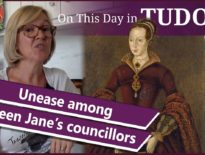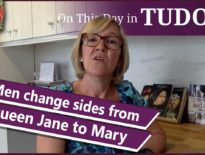On this day in Tudor history, 12th July 1553, Mary (future Mary I) moved from Kenninghall to Framlingham and set about rallying support. Sir Thomas Cornwallis was able to intercept her on her journey and pledge his loyalty to her. He wasn't the only one flocking to her cause.
Meanwhile, back in London, the new queen, Queen Jane (Lady Jane Grey), made a serious mistake by refusing to send her father to go and apprehend Mary.
Why was this a mistake?
Find out what was going on back in 1553 in this talk.
Also on this day in Tudor history, 12th July 1543, King Henry VIII got married for the sixth and final time. The fifty-two-year-old king married thirty-one-year-old Catherine Parr, Lady Latimer, in the Queen’s Closet of the Chapel Royal at Hampton Court Palace. Hear a contemporary account of the wedding service and find out who attended it in last year’s video:
Also on this day in history:
- 1537 – Execution of Robert Aske, lawyer and rebel. He was hanged in chains outside Clifford's Tower, the keep of York Castle. Aske was one of the leaders of the rebels in the 1536 northern uprising known as the Pilgrimage of Grace.
- 1549 – The rebels of Kett's Rebellion set up camp on Mousehold Heath, overlooking Norwich.
- 1555 – Burnings of preachers John Bland and John Frankesh, rector Nicholas Sheterden and vicar Humphrey Middleton at Canterbury. They were all Protestants burned for heresy.
- 1581 – Death of Maurice Chauncy, martyrologist, Carthusian monk and prior of Sheen Anglorum Charterhouse at Nieuwpoort in Flanders. He died in the Paris Charterhouse on his way back to Flanders from Spain, where he had been trying to get funding for the Charterhouse.
- 1584 – Death of Stephen Borough, navigator and naval administrator, at Chatham in Kent. He was buried in St Mary's Church, Chatham. His memorial brass paid tribute to his career:
“He in his lifetime discovered Moscovia, by the northern sea pasage to St Nicholas, in the yere 1553. At his setting forth of England he was accompanied in his ship by Sir Hugh Willoughbie, being Admirell of the fleete, who, with all the company of the said two shippes, were frozen to death in Lappia the same winter. After his discoverie of Roosia and the costes adjoyning to wit Lappia, Nova Zembla, and the c***ry of Samoyeda etc: he frequented the trade to St Nicholas yearlie, as chief pilot for the voyages, until he was chosen one of the four principal Masters in ordinarie of the Queen's Majesties royall Navy, where in he continued in charge of sundrie sea services till time of his death.” - 1598 – Execution of John Jones, Franciscan friar, at St Thomas's Waterings, Southwark. He was hanged, drawn and quartered for being a Catholic priest.
Transcript:
On this day in Tudor history, 12th July 1553, in the month of three Tudor monarchs, Mary, half-sister of the late king, Edward VI, moved from her estate of Kenninghall to Framlingham Castle, where she began to rally support.
In his contemporary account of Mary’s fight for the throne in 1553, Robert Wingfield lists some of the men who flocked to Mary’s cause, men like Henry Radcliffe, Earl of Sussex; Thomas Lord Wentworth; Sir Henry Bedingfield; Edmund Rous, Thomas Brend, John Colby and John Jennings, who all carried out Mary’s orders with speed and zeal, and who, with hard work, “turned an unskilled and disorganised mob into skilled and disciplined soldiers obedient to orders and eager to meet the enemy.”
In the days that followed, according to Wingfield, Mary visited her troops and was described as their gentle and beloved mistress. Wingfield writes that the soldiers “offered her such reverence that I had serious doubts whether they could have given greater adoration to God if he had come down from Heaven.” He also writes of Mary speaking to her forces with “exceptional kindness”, a wonderfully relaxed approach, and states that she won everyone's affections.
As I said in yesterday’s talk, it was also on this day in Ipswich that Sir Thomas Cornwallis, Sheriff of Norfolk and Suffolk, recanted his previous day’s proclamation regarding Queen Jane being the rightful queen and proclaimed Mary as queen instead. He also met Mary while she was on her way to Framlingham and “most humbly prostrated himself before her Highness”, both to beg a pardon for his “misdeed” and “to offer his due fealty on behalf of Norfolk and Suffolk” by surrendering his white staff of office to her. Wingfield records how, at first, Mary “seemed to berate the man for being somewhat slow and stubborn and less mindful of his duty than he ought to have been despite the repeated requests of her letters”, but, according to Wingfield, “soon the tender-hearted sovereign saw how utterly miserable he was at what he had done” and granted him mercy and made him one of her council.
Meanwhile, in the city of Norwich, in Norfolk, Mary was proclaimed queen.
Back in London, on Queen Jane’s side of things, a muster was called on Tothill Fields, Westminster, and according to “The Chronicle of Queen Jane and of Two Years of Queen Mary, and Especially of the Rebellion of Sir Thomas Wyat”, Queen Jane’s council decided that Jane’s father, Henry Grey, Duke of Suffolk, should go “with certain other noblemen” to apprehend Mary and to bring her to London. However, that same night, Suffolk’s mission was cancelled after Queen Jane “with weeping tears” implored her council to let her father stay at home with her. So, instead, her father-in-law, the Duke of Northumberland, was persuaded to go. This was a huge mistake, for Northumberland could have held Jane’s council together and kept them loyal to her.



Leave a Reply